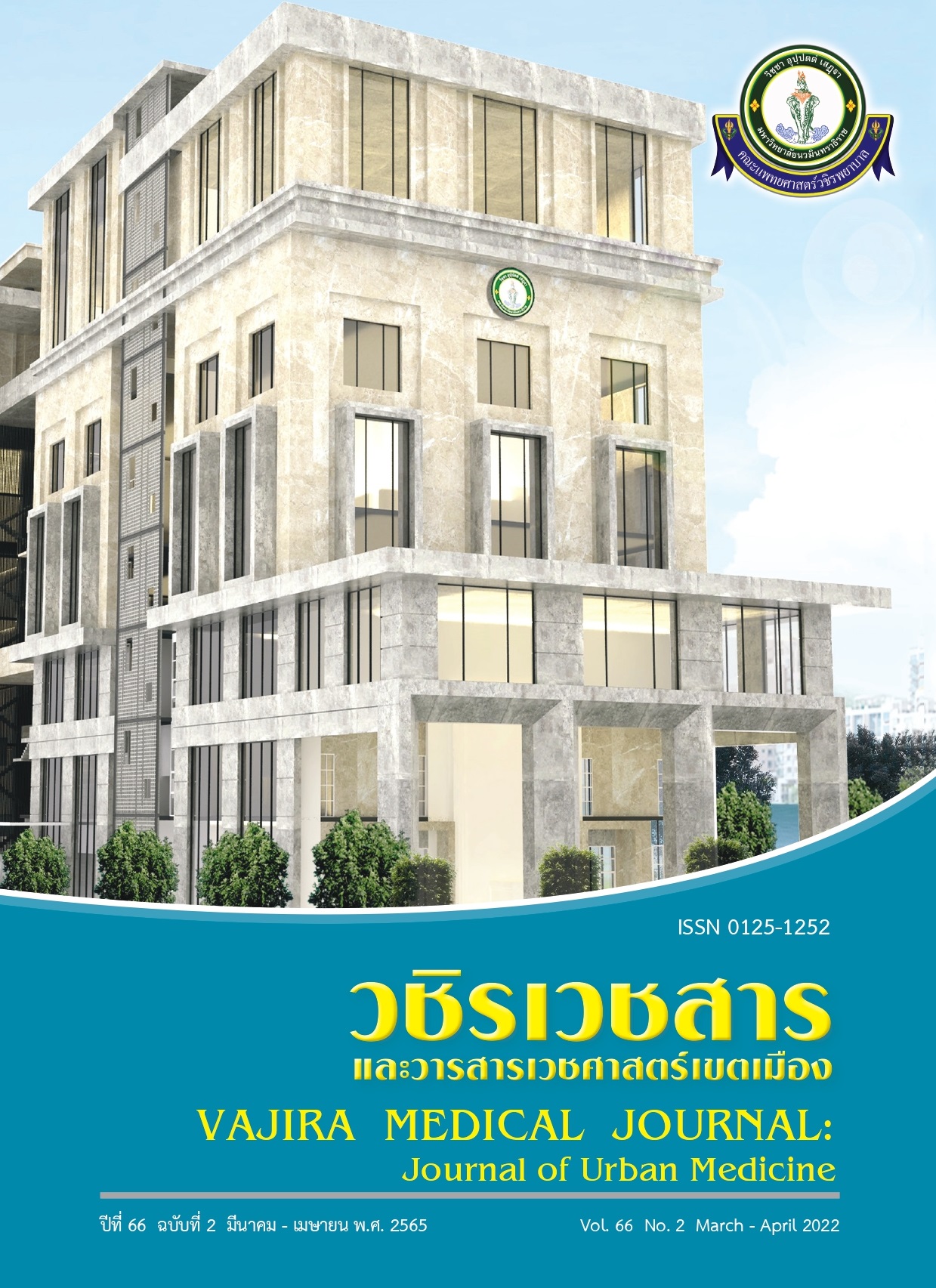Comparison of the Speech Performance of Thai Adults with Apraxia of Speech and Thai Adults with Normal Speech by Using the Apraxia Test for Thai Adults
Main Article Content
Abstract
Objective: To measure and analyze the speech performance score of adults with apraxia of speech (AOS) and adults with normal speech and to compare the speech performance scores of both groups.
Methods: The study was conducted at the Speech Clinic in Ramathibodi Hospital. Participants were divided into two groups. The measurements of speech performance were obtained by using the Apraxia Test for Thai Adults. The test results were analyzed by using descriptive statistics and a Mann-Whitney U test for a comparison of the speech performance scores of both groups.
Results: The results showed that the group of adults with normal speech had higher scores on all subtests than the group of adults with apraxia of speech (AOS). The results also showed that the group of adults with normal speech had statistically significant differences (p-value < .05) on subtests I, II, III, IV, and some tasks in subtests V, VI, and VII. The group of adults with AOS had more difficulties with both speech and nonspeech tasks than the group of adults with normal speech.
Conclusion: Adults with AOS showed the adverse effects of the impairment on their speech performance scores. They had more difficulties in moving their articulators to produce speech sounds while adults with normal speech did not have impaired movements of their articulators or restricted speech production.
Downloads
Article Details

This work is licensed under a Creative Commons Attribution-NonCommercial-NoDerivatives 4.0 International License.
References
Darley FL, Aronson AE, Brown JR. Motor speech disorders. Philadelphia: W.B. Saunders; 1975.
Josephs KA, Duffy JR, Strand EA, Machulda MM, Senjem ML, Master AV, et al. Characterizing a neurodegenerative syndrome: primary progressive apraxia of speech. Brain 2012;135(5):1522-36.
Balasubramanian V, Max L. Crossed apraxia of speech: a case report. Brain Cogn 2004;55(2):240-6.
Duffy JR. Motor speech disorders; substrates, differential diagnosis, and management. 3rd ed. St. Louis: Elsevier Mosby; 2013.
Sarankawin C. Apraxia test for Thai adults performance of subjects aged 20 to 65 years [thesis]. Bangkok: Mahidol University; 2002.
Roy EA, Heath M, Westwood D, Schweizer TA, Dixon MJ, Black SE, et al. Task demands and limb apraxia in stroke. Brain Cogn 2000;44(2):253-79.
Gross RG, Grossman M. Update on apraxia. Curr Neurol Neurosci Rep 2008;8(6):490-6.
Haaland KY, Harrington DL, Knight RT. Spatial deficits in ideomotor limb apraxia: a kinematic analysis of aiming movements. Brain 1999;122(6):1169-82.
Icht M. Ben-David BM. Oral diadochokinesis rates across language: English and Hebrew norms. J Commun Disord 2014:48:27-37.
Ziegler W. Task-related factors in oral motor control: speech and oral diadochokinesis in dysarthria and apraxia of speech. Brain Lang 2002;80(3):556-75.
Wang Y, Kent RD, Duffy JR, Thomas JE. Analysis of diadochokinesis in ataxic dysarthria using the Motor Speech Profile ProgramTM. Folia Phoniatr Logop 2009;61:1-11.
Pierce JE, Cotton S, Perry A. Alternating and sequential motion rates in older adults. Int J Lang Commun Disord 2013;48(3):257-64.
Hurkmans J, Jonkers R, Boonstra AM, Stewart RE, Reinders-Messelink HA. Assessing the treatment effects in apraxia of speech: introduction and evaluation of the Modified Diadochokinesis Test. Int J Lang Commun Disord 2012;47(4):427-36.
Tjaden K, Watling E. Characteristics of diadochokinesis in multiple sclerosis and Parkinson’s Disease. Folia Phoniatr Logop 2003;55(5):241-59.
McNeil MR, Weismer G, Adams S, Mulligan M. Oral structure nonspeech motor control in normal, dysarthric, aphasic and apraxic speakers: isometric force and static position control. J Speech Hear Res 1990;33(2):255-68.
Square-Storer P, Darley FL, Sommers RK. Nonspeech and speech processing skills in patients with aphasia and apraxia of speech. Brain Lang 1988;33:65-85.
Code C. Models, theories and heuristics in apraxia of speech. Clin Linguist Phon 1998;12:47-65.
McNeil MR, Pratt SR, Fossett TRD. The differential diagnosis of apraxia of speech. In : Maassen B, Kent RD, Peters HFM, Hulstijn W, editors. Speech motor control in normal and disordered speech. New York: Oxford University Press;2004. p. 389-413.
Head H. Hughlings Jackson on aphasia and kindred affections of speech. Brain 1915;38:1-27.
Ziegler W. Speech motor control is task-specific: evidence from dysarthria and apraxia of speech. Aphasiology 2003;17:3-36.
McCaffrey P. Neuropathologies of swallowing and speech [ Internet]. California; 1998 [cited 2019 Mar 30]. Available from: http://www.csuchico.edu/~pmccaffrey/syllabi/SPPA342unit8.html.
De Renzi E, Pieczuro A, Vignolo LA. Oral apraxia and aphasia. Cortex 1966;2:50-73.
LaPointe LL, Wertz RT. Oral-movement abilities and articulatory characteristics of brain-injured adults. Percept Mot Skills 1974;39:39-46.
Sturtevant AH. A new inherited character in man [homepage on the Internet]. Proc Nati Acad Sci USA; 1940 [cited 2019 May 4]. Available from: http://learning.genetics.utah.edu/content/basics/observable.
Ogar J, Willock S, Baldo J, Wilkins D, Ludy C Dronkers N. Clinical and anatomical correlates of apraxia of speech. Brain Lang 2006;97(3):343-50.
NHS. Stroke [ Internet]. NHS; 2019 [cited 2020 Oct 14]. Available from: https://www.nhs.uk/conditions/stroke/recovery/.
Ogar J, Slama H, Dronkers N, Amici S, GornoTempini ML. Apraxia of speech: an overview. Neurocase 2005;11(6):427-3.
Mlcoch AG, Square PA. Apraxia of speech:articulatory and perceptual factors. In: Lass NJ, editor. Speech and language: advances in basic research and practice vol.10. Florida: Academic Press;1984: p. 1-57.
Ziegler W. Apraxia of speech. In Goldenberg G, Miller BL, editors. Handbook of Clinical Neurology. 3rd ed. Edinburgh: Elsevier;2008. p. 269-85.
Roseberry-Mckibbin C, Hegde MN. An advanced review of speech-language pathology: Preparation for NESPA and comprehensive examination. Texas: Pro-ed;2000.


